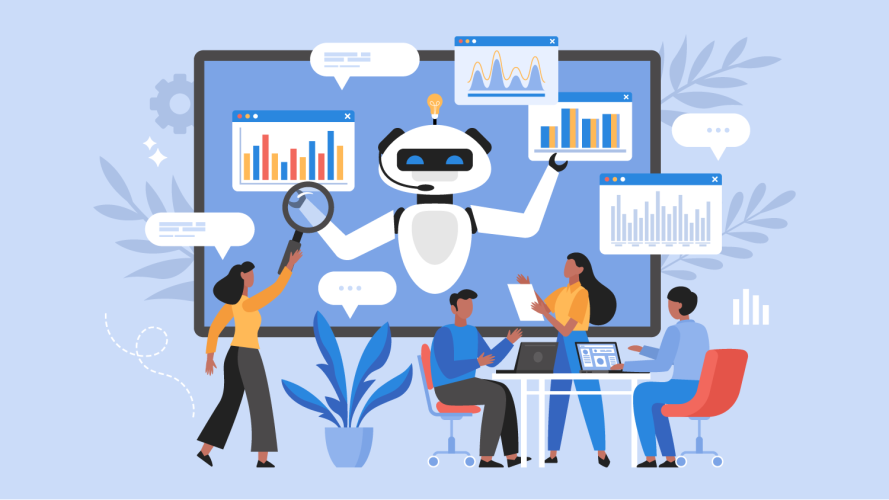This Will Make or Break Your Generative AI Initiatives

The AI revolution is actually a data revolution. To succeed, AI should be fed accurate, updated, complete data. You can take these steps now to get your data house in order.

Lisa Lee
What is the most important action you can take to successfully implement generative AI? If you said ‘managing data,’ give yourself a pat on the back.
New research highlights this reality: a company’s AI strategy is only as strong as its data strategy; 87% of analytics and IT leaders say that enormous (and enormously fast) advancements in AI make data management a higher priority.
But only 57% of data and analytics leaders are 100% confident in the quality, accuracy and completeness of their data, with line-of-business departments even less confident.
The data difference
Generative AI promises to significantly reshape how you manage your customer relationships, but it requires data that is accurate, updated, accessible, and complete.
- This is called data-centric AI, and is predicated on the notion that AI systems are developed using only quality data.
- It also requires companies to have a connected, up-to-the-minute view of customer’s activity.
The Trailblazer view
“You might have data available but is it current, authoritative, and complete?” said Carl Brundage, a certified technical architect specializing in data and analytics at Odaseva. “If not, you might not have a complete picture of your customer.”
Having the complete picture — knowing what, when, why, and how your customer does something – is the key to adding valuable context to AI.
What your company can do now
While some of the most impactful AI tools for businesses are still being developed, there are some key steps your business can take now to get its data house in order:
- Ensure the quality of your data. Remove duplicates, outliers, errors, and other things that can negatively affect how you make decisions.
- Connect your data sources — marketing, sales, service, commerce – into a single record, updated in real time, so the AI can make the best recommendations.
Indeed, lack of data harmonization is second only to security threats as the biggest barrier to extracting value from data. According to Salesforce research, the downstream effect of siloed data – no single source of truth – is a big concern for business leaders, who struggle to effectively use their own data.
What 10,000 technical and business leaders say about data
Lack of trust in their company’s data is stoking fears of missing out on generative AI’s benefits. Data governance is a key part of building a foundation for AI success. But that’s not all.



Lay the groundwork for data-centric AI
Customer data is at the heart of delivering great experiences. Your data does not need to be perfect to build an effective AI program, but it needs to be clean. That means free of errors, incorrect formats, duplicates, or mislabelings.
The data experts at Tableau offer these steps on how to clean your data, an important first step in unifying data sets for AI projects:
Remove duplicate or irrelevant observations
Duplication happens when you combine data sets from multiple places, and duplicate entries are created. Irrelevant observations happen when data (say, on older consumers) doesn’t fit into a problem you’re trying to analyze (say, millennial shopping habits). Removing these makes analysis more efficient, useful, and accurate for an AI system.
Fix structural errors
This happens when data includes typos, incorrect capitalization, or mislabelings. For example, “N/A” and “not applicable” mean the same thing, but are not analyzed the same way because they’re rendered differently. The entries should be consistent to ensure accurate and complete analysis by the AI system.
Filter unwanted outliers
There are often one-off observations that don’t appear to align with the data you’re analyzing. That might be the result of incorrect data entry (and should be removed) but sometimes the outlier will help prove a theory you’re working on. In any case, analysis is needed to determine its validity.
Handle missing data
Missing or incomplete data is a very common problem in data sets, and can reduce the accuracy of AI models. There are a few ways to deal with this:
- Eliminate observations that include missing values; however, this will result in lost information.
- Input missing values based on other observations; however, you may lose data integrity because you’re operating from assumptions and not actual observations
- Consider altering the way the data is used to effectively navigate the missing values.
Validate
After cleaning the data, you should be able to answer these questions:
- Does the data make sense?
- Does the data follow the appropriate rules for its field?
- Does it prove or disprove your theory, or surface any insight?
- Can you find trends that help inform the next theory? If not, is that because of continued data quality issues?
Data-centric AI + CRM = killer combo
AI has already begun to transform CRM and the way companies connect with and serve their customers. AI is useless without good data that is integrated, accurate, and real-time. At the same time, making sense of your mountains of data is impossible without AI.
The winning approach is combining the two practices. Doing so will help you identify and foresee trends, challenges, and opportunities across all lines of business — and serve your customers better.
A unified customer profile, enabled by Data Cloud, gives you a comprehensive view of your users, whether they are visitors, customers, prospects, or subscribers. Historically, marketing data has been locked inside marketing systems, service data in service systems, etc., which doesn’t give you the complete picture of your customer’s activity.
“There’s absolutely a need to have a trusted unified customer profile, in one place and updated in real time,” said Brundage. “Something you did last month, you may do differently this month, based on the data. And if you have outdated data, that’s what AI will use.”
There’s a famous pyramid which demonstrates the hierarchy of knowledge management. Data sits at the bottom, representing everything we collect, progresses to information, then knowledge, and finally wisdom, which sits at the top.
Data and information provide little context or answer the “why” of anything. But with integrated, real-time data layered with AI, you can see patterns, predict trends, and make connections between things that on the surface might not seem to go together.
“Knowledge is knowing that a tomato is a fruit,” Brundage said. “Wisdom is knowing it does not go into a fruit salad.”



























